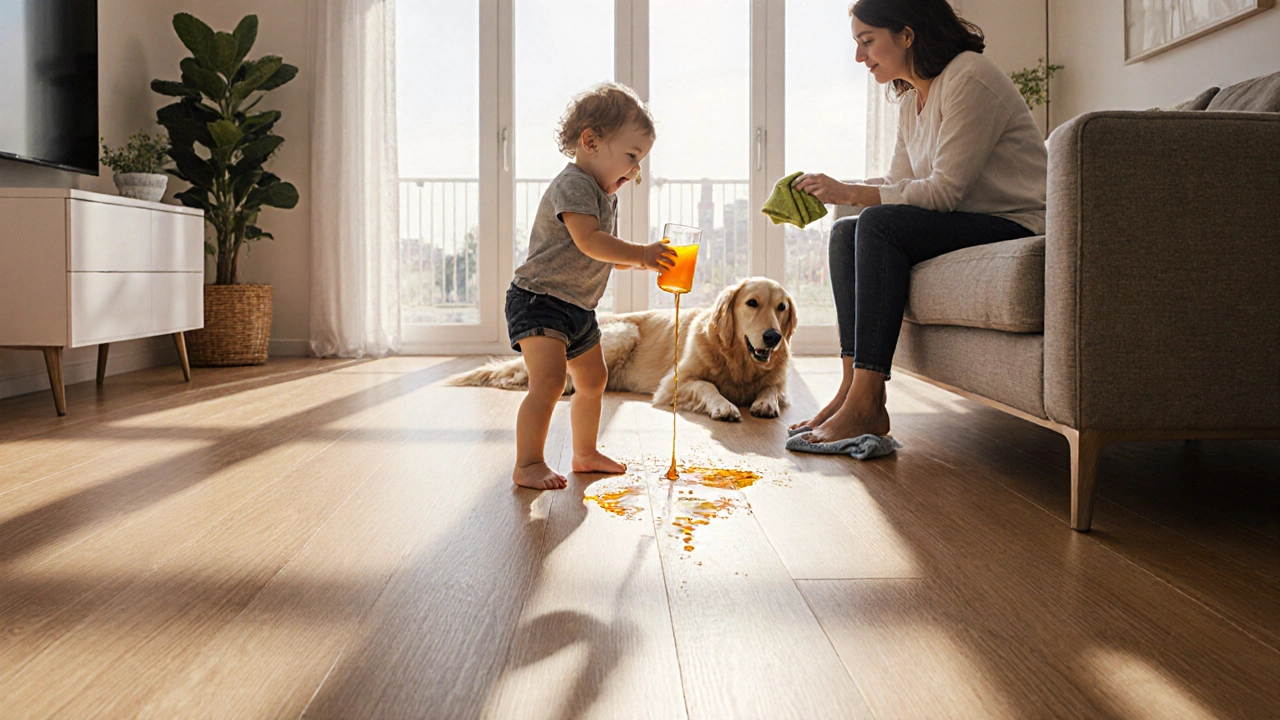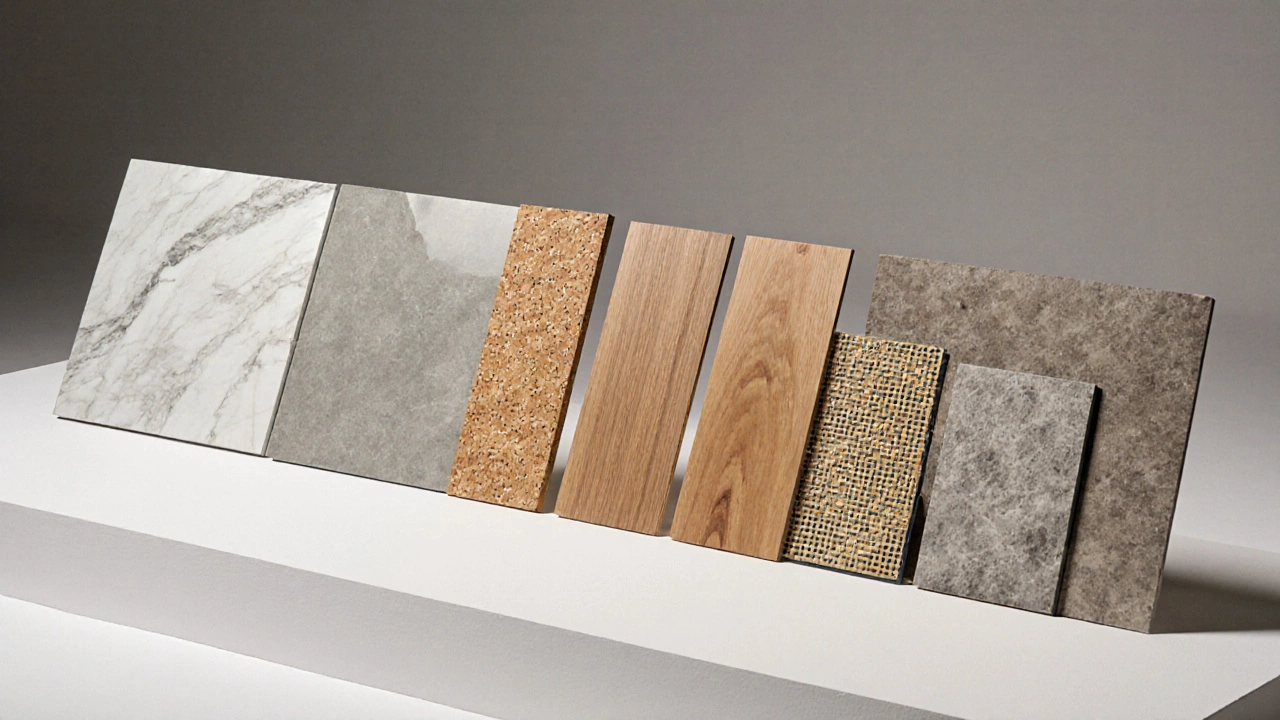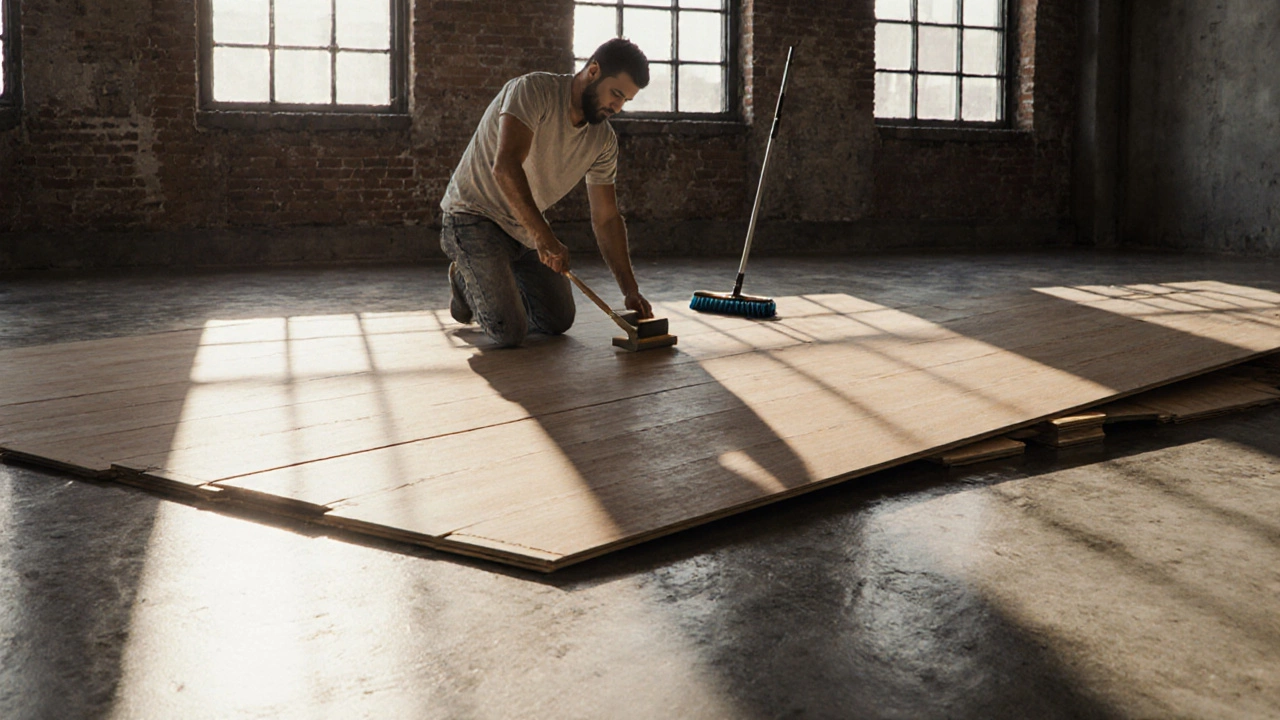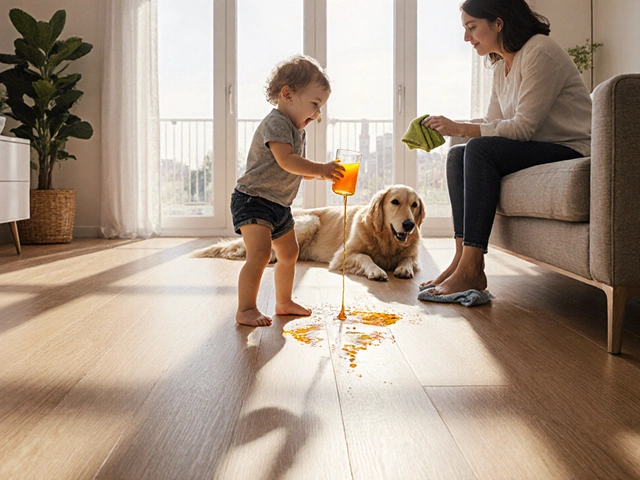Best Low‑Maintenance Flooring Options for Easy Upkeep

Flooring Comparison Tool
Find Your Perfect Flooring Match
Select your priorities to see which flooring materials best fit your needs. Answer these 3 questions to get personalized recommendations.
Water Resistance Needed
Home Environment
Preferred Look & Feel
Key Takeaways
- Luxury vinyl plank and ceramic tile top the list for water‑proof, scratch‑resistant durability.
- Concrete and rubber flooring are virtually maintenance‑free once sealed.
- Engineered hardwood offers a warm look with less upkeep than solid wood.
- Cost varies widely - from $2/sqft for basic laminate to $12/sqft for premium LVP.
- Regular simple cleaning (sweeping, occasional mopping) keeps most options looking fresh.
When you ask, “low maintenance flooring?” you’re probably juggling busy schedules, kids, pets, or just the desire to avoid endless scrubbing. The good news is that modern flooring options let you enjoy style without the chore list. Below we break down the most hassle‑free materials, what makes them tick, and how to pick the right one for your home.
What “low‑maintenance” really means
Low‑maintenance flooring isn’t a magic label; it’s a set of attributes that reduce the time and effort you spend on cleaning, repairs, and refinishing. The key traits are:
- Water resistance - prevents swelling, staining, or mold.
- Scratch and dent tolerance - ideal for pets and high‑traffic zones.
- Ease of cleaning - simple sweep‑and‑mop routines suffice.
- Longevity without refinishing - the surface stays good‑looking for years.
Materials that excel in most or all of these categories earn the low‑maintenance badge.
Top low‑maintenance flooring materials
Below is a quick‑look table before we dive into each product.
| Material | Maintenance Level | Water Resistance | Typical Cost (US$/sqft) | Durability (years) |
|---|---|---|---|---|
| Luxury Vinyl Plank (LVP) | Very low | Water‑proof | 4‑12 | 15‑25 |
| Ceramic Tile | Very low | Fully waterproof | 3‑8 | 30‑50 |
| Engineered Hardwood | Low | Water‑resistant (surface) | 5‑10 | 20‑30 |
| Polished Concrete | Very low | Water‑proof when sealed | 2‑6 | 40‑70 |
| Laminate | Low | Water‑resistant (some) | 2‑5 | 10‑20 |
| Rubber Flooring | Very low | Water‑resistant | 3‑9 | 15‑25 |
| Cork | Low | Water‑resistant (sealed) | 4‑8 | 15‑20 |
| Bamboo | Low | Water‑resistant (strand‑woven) | 5‑10 | 20‑30 |
1. Luxury Vinyl Plank (LVP)
Luxury vinyl plank mimics hardwood or stone without the upkeep. It’s completely waterproof, so spills wipe clean, and the top wear layer resists scratches. Installation can be click‑lock (DIY‑friendly) or glue‑down for commercial‑grade projects. Most homeowners report a simple sweep‑and‑mop routine keeps it looking showroom‑new.
2. Ceramic Tile
Tile has been the go‑to for bathrooms and kitchens for decades, and for good reason. Glazed ceramic is impervious to water, stain‑proof, and can handle abrasive cleaning agents. Grout lines do need occasional sealing, but that’s a once‑or‑twice‑a‑year task. With a vast design library, you can achieve everything from sleek subway looks to intricate mosaics.

3. Engineered Hardwood
Engineered hardwood layers a real wood veneer over a plywood core. The veneer gives you the warm grain feel while the core provides dimensional stability. Unlike solid hardwood, engineered boards tolerate a bit of moisture, making them suitable for basements with proper subfloor prep. A simple dust mop and occasional wood‑safe cleaner keep them vibrant.
4. Polished Concrete
Concrete floors, once polished and sealed, become a sleek, industrial‑style surface that’s almost indestructible. The sealant creates a water‑tight barrier, so you only need to dust mop and mop with a neutral pH cleaner. Because the material is already part of the slab, installation costs are low if you’re remodeling a space with an existing concrete slab.
5. Laminate
Modern laminate has improved dramatically. A high‑density fiberboard core topped with a photographic layer and a clear wear coat gives a wood‑like look without real wood’s maintenance. While not 100% waterproof, water‑resistant laminates handle occasional spills if you dry them quickly. A dry mop or vacuum keeps dust from scratching the surface.
6. Rubber Flooring
Rubber tiles or sheets are popular in home gyms, mudrooms, and pet areas. They’re naturally slip‑resistant, cushiony, and repel water when sealed. Cleaning is a breeze - just sweep or vacuum, then mop with mild soap. The material also muffles sound, a nice side benefit for multi‑story homes.
7. Cork
Cork is renewable, warm underfoot, and surprisingly resilient. When sealed, it resists moisture and stains. A quick vacuum or dry mop removes debris; a damp mop with a cork‑friendly cleaner restores shine. It’s a great choice for living rooms where you want comfort without the fuss of carpet.

8. Bamboo
Strand‑wound bamboo is harder than many hardwoods and holds up well to traffic. It’s water‑resistant when finished with a high‑quality sealant. Maintenance mirrors engineered hardwood: dust mop, occasional mop with a gentle cleaner, and re‑seal every 3‑5years for optimal protection.
How to choose the right floor for your lifestyle
Pick a floor by matching its strengths to your daily routine:
- Pets & kids: LVP, rubber, or tile - they shrug off scratches and spills.
- Moisture‑prone rooms: Tile, LVP, or polished concrete - fully waterproof.
- Warm, natural feel: Engineered hardwood, cork, or bamboo - softer underfoot but still low‑effort.
- Budget constraints: Laminate and basic LVP offer the best price‑to‑performance ratio.
Don’t forget subfloor preparation. Even the toughest material will suffer if the base is uneven or not properly sealed. A simple moisture barrier under laminate or a primer for concrete can extend the life of your floor dramatically.
Cleaning & care tips that keep any low‑maintenance floor looking fresh
- Daily sweep or vacuum: Remove grit that could act as an abrasive.
- Weekly mop: Use a cleaner recommended by the manufacturer; for most floors, a mixture of warm water and a few drops of dish soap works.
- Spot‑treat spills immediately: Even water‑proof floors look best when liquids aren’t left to sit.
- Avoid harsh chemicals: Acidic or bleach‑based cleaners can dull wear layers on LVP and laminate.
- Re‑seal when needed: Concrete, cork, and bamboo benefit from resealing every few years.
Cost and installation insights
Below is a quick cost snapshot (material only, not labor):
- LVP: $4‑12 per sqft - DIY click‑lock saves labor.
- Ceramic Tile: $3‑8 per sqft - labor can add $5‑10 per sqft.
- Engineered Hardwood: $5‑10 per sqft - professional installation recommended.
- Polished Concrete: $2‑6 per sqft - sealing adds $1‑2 per sqft.
- Laminate: $2‑5 per sqft - ideal for DIY.
- Rubber: $3‑9 per sqft - usually installed in rolls.
- Cork: $4‑8 per sqft - sealant extra.
- Bamboo: $5‑10 per sqft - similar to engineered hardwood.
If you’re on a tight timeline, click‑lock LVP or laminate can be laid over most existing floors in a single weekend. For a high‑end look that lasts decades, invest in tile or polished concrete - the upfront labor cost is higher but the maintenance savings quickly pay off.
Frequently Asked Questions
Which floor is truly waterproof?
Luxury vinyl plank (when it has a 100% waterproof core) and glazed ceramic tile are completely waterproof. Polished concrete and sealed cork also become water‑tight after proper sealing.
Can I install LVP over existing carpet?
Yes, as long as the carpet is securely glued down and the surface is level. Many DIYers use a thin underlayment to smooth out minor imperfections before laying the planks.
How often should I reseal a concrete floor?
Most sealers last 3‑5years in residential use. Test the surface by sprinkling water; if it beads, the seal is still good. If it soaks in, re‑apply.
Is cork a good choice for a kitchen?
Cork works well in kitchens if you seal it properly. The seal protects against spills, and the natural softness is gentle on dropped dishes.
What’s the quietest floor option?
Rubber flooring and cork are the quietest because they absorb impact sound. Adding a thin underlayment under laminate or LVP also reduces footfall noise.
Bottom line: you don’t have to sacrifice style for simplicity. By picking a material that matches your traffic patterns, moisture exposure, and budget, you’ll enjoy a floor that looks great and barely needs attention. Happy flooring!
